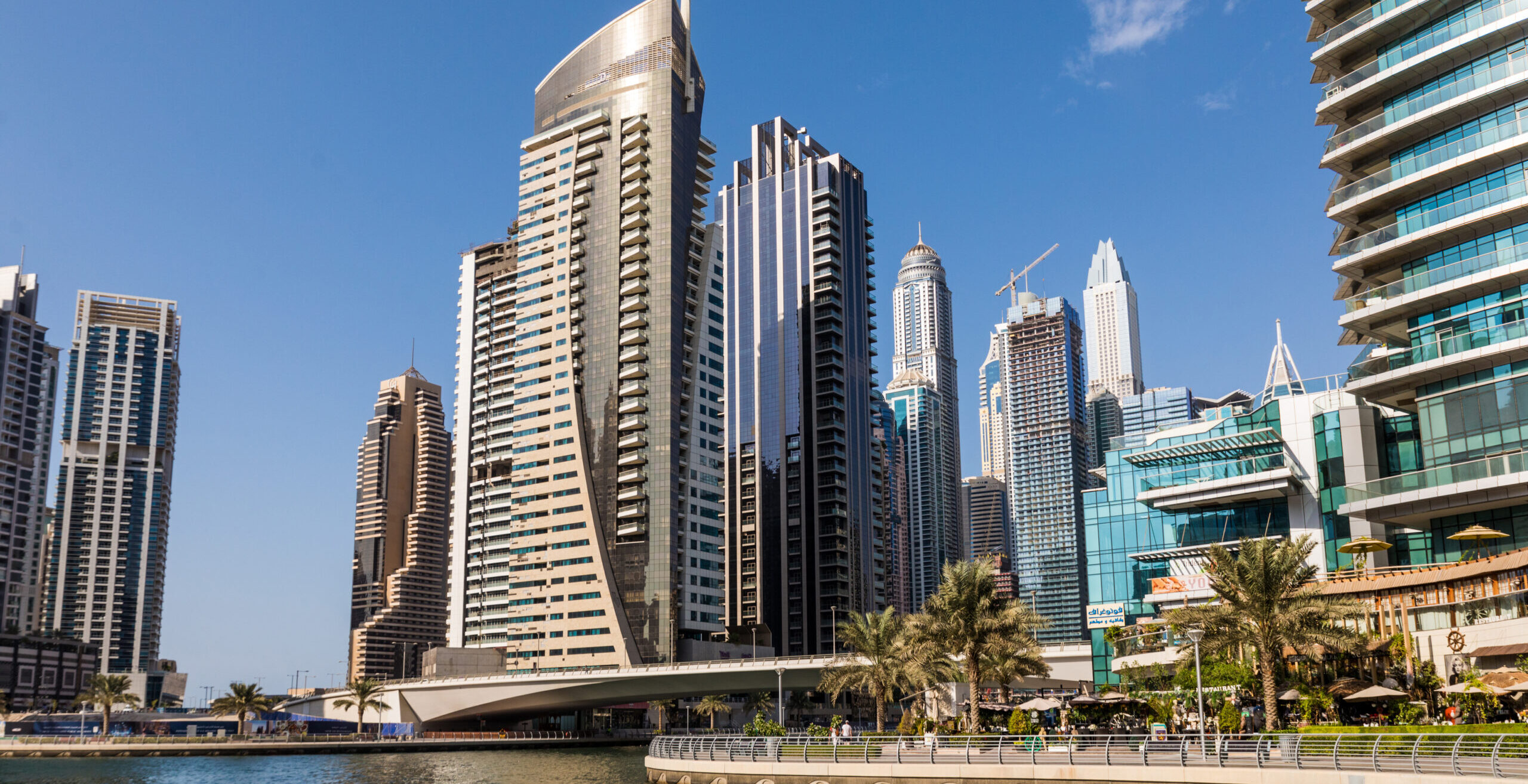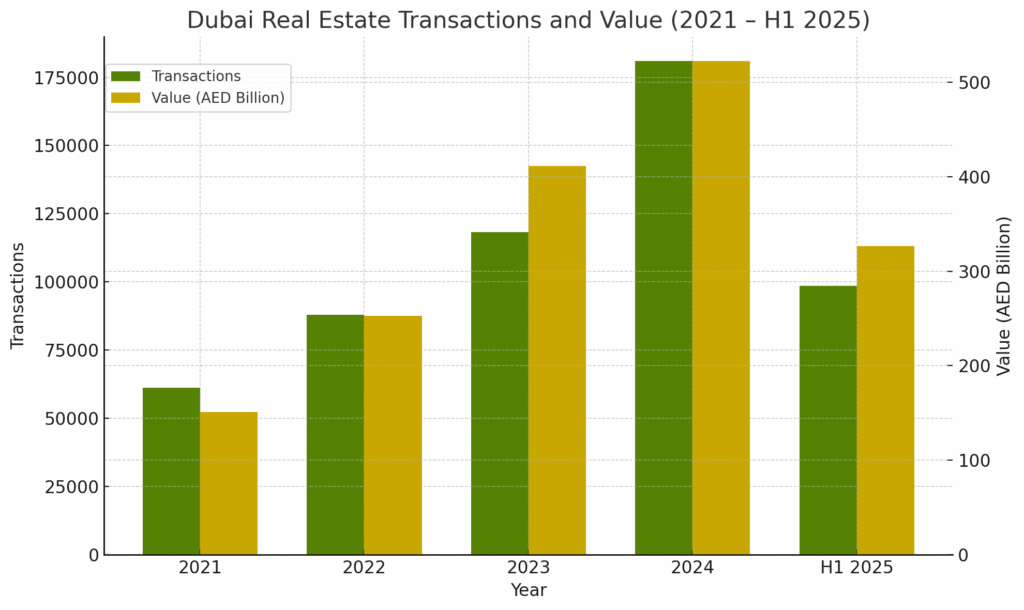
Dubai 2040: Your Roadmap to Smart Real Estate Investment
By Ikigai Real Estate
Dubai’s property market sustained its record-breaking trajectory in the first half of 2025, with unprecedented sales volumes and values reinforcing the city’s status as a global investment magnet. This momentum builds on steady, consistent growth over the past four years, demonstrating the market’s resilience and maturation. As the Dubai 2040 Urban Master Plan accelerates into implementation, the recent data also provides more than just market context; they pinpoint where the future is being built.
What’s Driving the Dubai Property Market?
Dubai’s real estate market has been on a steady upward climb. In 2021, both transaction volume and value saw a major jump from the year before, and that momentum didn’t slow down. Each year since, we’ve seen double-digit growth, with 2023 breaking all previous records. By 2024, the market had grown another 36% in activity and 27% in value year-on-year (180,900 transactions valued at AED 522.1 billion), underscoring just how strong investor confidence has become.

The momentum has continued into 2025 with AED 326.64 billion in sales recorded across 98,462 transactions during the first six months of the year, marking a 40% year-on-year increase in value and a 22.7% rise in transaction count compared to H1 2024. Q2 2025 alone delivered AED 184 billion in 53,118 deals – the strongest quarter ever. June 2025 sales reached AED 54.21 billion, the fourth-highest monthly total on record, despite the Eid al-Adha holiday.
Dubai’s property market is being powered by several long-term structural drivers. First, the population boom is accelerating beyond expectations. As of June 2025, Dubai reached 3.95 million residents (an increase of 110,000 in just six months) and is now on track to surpass 4 million by Q3, well ahead of the 2040 projection of 5.8 million. This growth is reinforced by the ambitious D33 Agenda, which aims to double Dubai’s economy to AED 32 trillion by 2033. The plan is expected to draw AED 650 billion in foreign investment and expand Dubai’s trading network to include 400 new global cities.
At the same time, infrastructure investment is ramping up at an unprecedented pace. Nearly half of Dubai’s 2025 budget, AED 39 billion, has been allocated to construction and infrastructure projects. A further AED 25 billion committed under the Urban Master Plan 2040 is designed to unlock AED 650 billion in private investment by the end of the decade. Supporting all this is Dubai’s push for clean energy transformation. By early 2025, the emirate had already achieved a 20% clean energy mix, progressing toward its goal of 75% by 2050, backed by the AED 100 billion Green Fund.
What makes the Dubai 2040 plan different from typical urban development?
Unlike traditional urban expansion focused purely on growth, Dubai 2040 represents a paradigm shift toward data-driven, scientifically planned development. The plan leverages a comprehensive planning database with 3,000+ indicators for decision-making and integrates AI-powered urban management systems that adapt in real-time to city needs. This isn’t just about building more. It is about building smarter through evidence-based planning that balances economic growth with environmental stewardship.
The 2040 plan aims to:
- Create a true “20-minute city”: Integrated service centres will ensure 55% of residents live within 800 meters of public transport, allowing access to 80% of daily needs within 20 minutes by foot or bicycle
- Unprecedented green space allocation: Allocate 60% of Dubai’s land to green spaces and nature reserves, doubling all green and recreational areas with 6,500 kilometers of walkways (3,300 km new, 2,300 km renovated)
- Revolutionary clean energy target: Achieve 75% clean energy adoption by 2050, with the Mohammed bin Rashid Al Maktoum Solar Park expanding to 5,000 MW capacity by 2030
- Smart infrastructure integration: Comprehensive planning database with 3,000+ indicators for decision-making and AI-powered urban management systems that adapt in real-time
- Rapid growth in tourism infrastructure: Hotel capacity will expand by 134% and public beaches by 400% by 2040 as tourism infrastructure grow to support the projected 7.8 million daytime population
For investors like you, this translates to predictable growth corridors where your investment can flourish within a scientifically planned ecosystem rather than speculative development patterns.
How to Read Market Cycles in Dubai
Dubai typically alternates 4-6 years of off-plan dominion with 5-6 years of secondary-market strength. As of July 2025, the current cycle has reached 59 months of continuous price growth, with H1 2025 monthly appreciation averaging 1.19% until the first dip of –0.57% in January 2025. Off-plan transactions comprised 66% of H1 2025 sales, with apartments making up 86.7% of new inventory.
Where are we now?
Dubai’s current market cycle reflects nearly five years of uninterrupted price appreciation. The market is showing signs of maturation while maintaining robust fundamentals.
- Record Price Growth and Transaction Value: In June 2025, the ValuStrat Price Index reached 220.8 points, marking a 1.5% monthly increase and a remarkable 23.9% annual growth. Total transactions hit 16,302-16,448 deals worth AED 54.2-54.8 billion, representing a 20.5% year-on-year increase in value.
- Critical supply surge looms: Dubai faces an unprecedented 80% increase in new property supply during 2025-2026, with 41,000 units in 2025 and 42,000 units in 2026 compared to just 27,000 units in 2024. This surge will create a 16% annual supply growth significantly outpacing 5% population growth.
- Market correction warning: Fitch Ratings predicts a “moderate correction” in H2 2025-2026 with prices potentially falling up to 15% as the record supply surge creates downward pressure. Off-plan dominance has intensified to 73.4% of total residential sales in June 2025.
This evolving mix of strong off-plan momentum, moderating price appreciation (down from 2.48% monthly peaks to 1.5%), and a significant shift in resale profiles suggests the market is maturing rapidly. With industry analysts forecasting a potential 10-15% correction in H2 2025-2026 due to unprecedented supply increases, discerning property selection and strategic timing will be increasingly critical as Dubai approaches the next phase of its cycle.
Where Should You Put Your Money?
The Master Plan has created distinct investment ecosystems, each with its own appeal. Let’s look at where the smart money is flowing:
1. Transit-Connected Communities
Properties within 500 meters of metro stations now command 15-18% valuation premiums. The Dubai South “The Pulse” community, for example, has achieved 14% annual price growth since 2023, fuelled by the Route 2020 extension. Why? The Dubai Metro Blue Line project, a 30-km line with 14 stations connecting high-potential areas like Dubai Creek Harbour and Silicon Oasis, is making these locations increasingly desirable.
2. The Next Infrastructure Game-Changer
The next transit-connected transformation wave will come with the launch of Etihad Rail’s high-speed passenger service. The 350 km/h passenger line will cut Dubai to Abu Dhabi travel to 30 minutes and feed stations at Al Maktoum Int’l Airport and Al Jaddaf. Brokers forecast 10-15% capital uplifts for homes within walking range of planned stops, mirroring the 15-18% metro premium already priced in Dubai. Communities such as Arabian Ranches 2, Damac Hills, Town Square, Al Furjan and Mudon are seeing early interest spikes. Macro-impact estimates put the rail network’s lifetime GDP boost at AED 145 bn.
3. Green-Adjacent Properties
Meydan anchors Sheikh Mohammed’s aim to give Dubai its “greenest urban heart,” blending 2.4 m sq. m of parks, waterways and the world’s largest crystal lagoon into Mohammed Bin Rashid City – District One. A new AED 245 m beautification drive has landscaped 302,000 sq. m around Al Meydan/Al Khail junction, installing smart irrigation that saves 30% water. Proximity to such blue-green assets already carries 8-12% rent premiums in Al Barari and Creek Harbour, and analysts expect Meydan to match or exceed that as its low-density master plan matures.
4. Dubai’s Car-Free “Super Block” Plan
Dubai will pilot Spanish-style “super blocks,” turning Al Fahidi, Abu Hail, Al Karama and Al Quoz Creative Zone into car-free neighbourhoods prioritising walkers and cyclists. The initiative forms part of a 6,500 km Dubai Walk network that seeks to double soft-mobility share to 25% by 2040 while expanding green space. Expect investor attention to refocus on mixed-use plots inside these zones as street-level footfall increases.
5. Tech-Integrated Developments
Smart is becoming standard. A case in point is the Dubai Urban Tech District (opening 2026), which will host AI-managed systems and geothermal cooling targeting net-zero carbon status in 70% of its buildings. In fact, properties in tech hubs now see 4-8% occupancy premiums.
6. Sustainable Investments
Going green isn’t just good for the planet, it’s also good for your wallet. LEED-certified commercial assets yield 33-34% rental premiums. Residential developments like The Sustainable City attracts 15-20% price premiums on residential units thanks to 100% renewable energy usage and 60% water savings.
7. Mixed-Use Developments
Why put all your eggs in one basket? Today’s mixed-use districts are living novels in which residential towers, boutique shops and creative studios converse in harmonic rhythms. In Expo City, former pavilions have been reborn as art galleries and co-working spaces, each step literally echoing the city’s underlying narrative of renewal. In fact, the first half of 2025 witnessed robust activity in Dubai’s mixed-use development sector with 35 mixed-use projects delivering 15,670 residential units and 180,000 sq. ft of commercial/retail space, capturing 7.2% of all initial sales across Dubai.
Period | Total New Projects | Mixed-Use Projects | Mixed-Use Units | Share of Initial Sales |
Q1 2025 | 95 | 32 | 8,140 | 6.8% |
Q2 2025 | 88 | 35 | 7,530 | 7.6% |
H1 2025 | 183 | 67 | 15,670 | 7.2% |
Sources: investindxb.com, zawya.com, gulfconstructiononline.com
Your Timeline for Investment Opportunities
The market dynamics have shifted significantly. Here’s a roadmap of key milestones based on current supply projections:
- 2025: Supply surge begins with 41,000 new units entering the market; moderate correction expected in H2 2025 with potential 5-10% price declines; Phase 1 metro and green-space projects completion
- 2026: Peak supply year with 120,000 units planned for handover (4x 2024 levels); correction continues with prices potentially down 10-15% from peak; Dubai Urban Tech District begins operations creating 4,000 jobs; Etihad Rail passenger service launches
- 2027: Market stabilisation as supply tapers to 19,000 units; correction bottoms out; prime locations begin recovery; Major infrastructure projects mature
- 2030: Recovery phase with metro network expansion to 96 stations across 140 sq. km; 5.8 million population milestone approached
- 2040: The Dubai vision is realised with 60% green spaces achieved; 8 million daytime population; 400% beachfront access expansion complete
What kind of returns can you actually expect?
Here’s what current data tells us:
Residential Yields: Properties in areas like Jumeirah Village Circle (JVC) are delivering 7.1-7.9% rental yields for 1-3 bedroom units as of 2025. However, the overall Dubai rental yield average is now 6.9% for apartments and 5.0% for villas. Studio apartments achieve the highest yields at 8.25% citywide, while 1-bedroom and 2-bedroom apartments generate 6.92% and 6.88% respectively.
Commercial Occupancy: Prime locations like Dubai International Financial Centre (DIFC) and Business Bay maintain exceptionally high occupancy rates. DIFC specifically reports an impressive 98% occupancy rate as of Q1 2025, while the broader prime business districts achieve 95-97% occupancy. Dubai holds the second-highest global office occupancy levels at 92% and is expected to exceed 94% by end-2025.
Luxury Market Growth: Dubai set a new record with 435 sales of ultra-premium properties valued above $10 million in 2024, generating $7.1 billion in total value. Q1 2025 continued this momentum with 111 luxury homes sold in the $10M+ bracket, marking the strongest first quarter on record. Q2 2025 broke new records with 143 transactions over $10 million, totalling $2.6 billion.
Sustainable Premiums: Green-certified buildings in Dubai command 25-30% higher rental rates than traditional properties. LEED-certified commercial assets secure rental premiums up to 33-34%, while sustainable office spaces in Downtown Dubai lease for AED 200-250 per square foot annually compared to AED 150-180 for conventional spaces. Residential sustainable properties command 15-20% price premiums.
Transit Premium: Properties within 500 m of Dubai Metro stations command 18–25% higher prices and 15–30% higher rents, with occupancy above 95%. Since 2019, this metro premium has risen from 12% to 22% in 2024, and areas near the Blue Line have seen rents climb 23% on average. The Etihad Rail’s 350 km/h line is expected to also add a 10-15% uplift to prices near its stations (e.g., Al Jaddaf: +5–7%; larger units up to +10%). Early growth is already visible in Arabian Ranches 2, Damac Hills, Town Square, Al Furjan and Mudon, as investors position for the new high-speed corridor.
Current Median Prices (June 2025): Dubai’s property market continues to defy expectations. Apartment prices are up nearly 20% year-on-year, while villa prices have surged even higher, with premium areas like Jumeirah Islands seeing jumps of over 40%. The average price per square foot in Dubai reached AED 1,607 in June 2025, representing an 8.3% increase from the January 2025 figure of AED 1,484. This reflects the continued upward trajectory of Dubai’s property market through the first half of 2025.
Market Performance: The average property price in Dubai reached AED 1,633,944 in Q2 2025, representing a 7.6% year-on-year increase. Off-plan properties are still dominating the market, making up 73.4% of all residential sales in June, while areas like JVC, Business Bay, and Dubai Marina continue to be the hottest spots for both investors and end-users. While some experts anticipate a market correction later this year, Dubai’s rapid population growth and limited housing supply continue to fuel investor confidence.
Property Price Segments: The AED 1-2 million price segment is currently the most active, representing 30% of all transactions, while the AED 2-3 million segment accounts for 18% of sales as of May 2025. Properties below AED 1 million comprise 26% of sales, indicating strong demand across all price points.
7 Smart Risk Management Strategies
Even in a booming market, smart investors protect themselves. Here’s how you can mitigate risk:
- Diversify across sectors: Aim for a balanced portfolio with 40% residential, 30% commercial, and 30% hospitality investments
- Spread geographically: Combine high-growth areas (Dubai South, Expo City) with established locations (Downtown, Palm Jumeirah)
- Research developers: Choose RERA-certified developers with 95%+ delivery rates and DLD-escrow-monitored payments.
- Protect against rate changes: Consider locking in 5-year fixed-rate mortgages at current rates (5.2%) while maintaining healthy loan-to-value (LTV) ratios of ≤76%.
- Cycle Awareness: Prepare for moderating growth as market maturity and affordability pressures rise.
- Leverage off-plan financing: Secure up to 50% LTV financing from banks for tier-one developers (Emaar, Nakheel, Meraas). This means you will pay roughly half during build and be able to defer 40% until handover, easing cash-flow pressure versus the traditional 70-80% self-funding model.
- Supply cycle timing: With 210,000 new units planned for 2025-2026 (double the previous three years), consider delaying major purchases until H2 2025 when increased supply may create buyer advantages.
Where Should You Start?
Dubai’s real estate market has entered a new phase: one where timing now outweighs location in determining return potential. With the forecasted price correction expected in H2 2025–2026 and a historic supply surge reshaping the landscape, the old “buy now” urgency no longer applies. We’re moving into a buyer’s market where strategy, liquidity, and patience matter more than ever.
For strategic investors, the smartest move may be to hold and observe through the second half of 2025, maintaining strong cash positions to take advantage of falling prices. Prime areas like Palm Jumeirah, Downtown Dubai, and DIFC are likely to remain more resilient and will be first to recover once the cycle turns.
If your focus is on stable rental income, suburban communities such as Dubai South and Dubailand stronger returns than central locations. Villas, in particular, are proving to be a resilient asset class—now accounting for a growing share of total transactions—reflecting investor preference for spacious, family-friendly homes in lower-density environments.
For those seeking long-term capital growth, attention is shifting toward future transit hubs, especially locations around the upcoming Dubai Metro Blue Line and Etihad Rail, due in 2026. These areas are projected to deliver considerable upside once infrastructure is complete. Properties adjacent to green corridors, such as those in Meydan, are already commanding rental premiums of 8-12%.
The most favourable buying window is expected to open between late 2025 and early 2026, when new supply peaks and prices hit their floor. However, investors should be wary of oversaturated zones like JVC and Business Bay, which will see nearly 47,000 units combined delivered by 2028.
In this environment, the advantage shifts to patient, well-capitalised buyers. It’s no longer about racing into the market but about being ready to strike when timing and fundamentals align.
“The future belongs to those who can imagine it, design it, and execute it.” – Sheikh Mohammed bin Rashid Al Maktoum

CONNECT WITH US
Whether you're a first-time investor or looking to expand your portfolio, the right guidance can help you navigate Dubai's dynamic market with confidence and clarity. Our team specialises in identifying properties with strong growth potential aligned with Dubai's 2040 vision. Contact us for a tailored consultation that puts your financial objectives at the centre of our recommendations.
Shalini AroraCo-founder and Senior Property Consultant